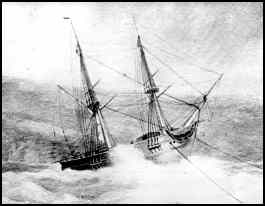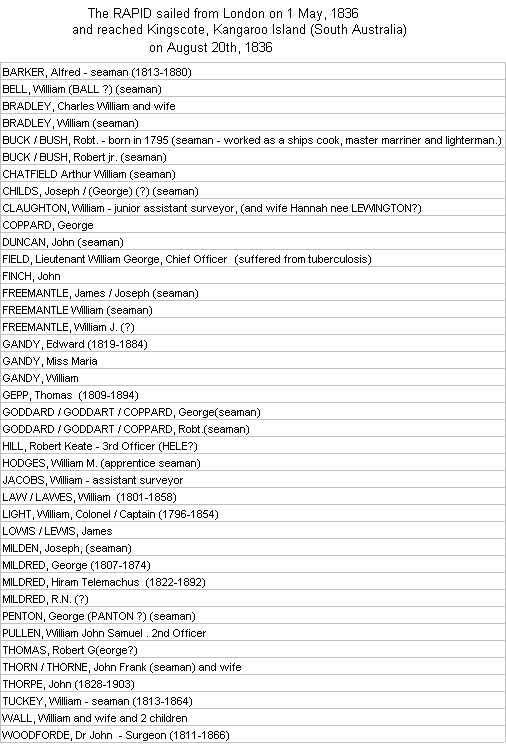RAPID 1836"RAPID" was 756 tons "old measure",three-masted square-rigged ship. She was built in 1826 by Frederick Preston at the Norfolk port of Yarmouth, and during her early years made trading voyages from various British ports to the Mediterranean - Gibraltar, Trieste, Zante, Constantinople, and even Odessa. She sailed from London on May 1st, 1836 close in the wake of the 3 vessels dispatched by the South Australian Company and reached Kingscote, Kangaroo Island, on August 20th, 1836. (Another source said she was 153 tons, left London on May 4th, and arrived on August 19th, 1836). |  Image courtesy of the State Library of South Australia (B.2006) |
but only chartered the CYGNET. RAPID's direct passage of 114 days to the new colony would be the fastest of the ships of 1836. |
"in addition to Col. William Light, who was in Command, the RAPID carried Messrs Field, Pullen, and Hill, as her First, Second and Third Officers, respectively." Colonel Light was appointed to the command of the RAPID, relinquishing it to first officer Lieutenant William George Field upon arrival at Kangaroo Island. Also on board were the following and a crew of 13 seamen.  |  1836 RAPID DIARY by William Pullen It is interesting to review the number of people taken to the new colony and to try and deduce where they might have been accommodated. Colonel Light was sent to Australia to survey South Australia and to select a site for the capital. He was accompanied by Dr John Woodforde (1810-1854) who remained in South Australia for the rest of his life, and his descendants still live there. The second and third officers were William Pullen and Robert Hill. The seven gentlemen 'of a superior Class whose Passage is not defrayed by the Emigration Fund' were no doubt these four officers, together with assistant surveyors William Jacob and William Claughton, and John Woodforde, surgeon to the survey. Maria Gandy, Light's mistress, seems to have been a supernumerary, and receives no official mention. They were probably allocated four cabins adjacent to the gunroom aft. The seventeen emigrants comprised Mrs Bradley (the wife of the boatswain), three surveyor's labourers, and thirteen 'well-selected seamen'. The crew in their forecastle, and some special arrangement such as small compartments in the cramped between-decks for the Bradleys and the labourers, and all is well. However one well-known passenger list has another nine names. Researched by: Stephen Butt 2004 Stephen Butt also mentions: Some, such as Gepp of Gepp's Cross, certainly came on subsequent voyages. Note: G.H. Pitt's Index (1932-33) lists arrivals between 1836 and 1845, and includes four passengers named Gepp: 1836 RAPID: Thomas Gepp; 1838 RAPID: Thomas Gepp 1840 FAIRLIE: Isaac Gepp/Jeff; The Pitt Index also lists another Thomas Gepp (OCD). |
|
Little time was lost upon arrival at the new settlement at Nepean Bay on August 22. Light had already taken the opportunity to observe the low line of sand hills stretching away to the east as the vessel came in past Encounter Bay, and the hatchboat had been hoisted out, rigged, and placed under Pullen's command. Light employed the boat to first make various excursions around the bay, and on September 7 set off in the RAPID to commence his examination of Gulf St Vincent. He was delighted with what he found. After a careful examination of RAPID Bay, they continued north to Yankalilla, Aldinga Bay, and the sandbanks off the entrance to a mangrove-lined inlet. Although boat parties managed to find the river, the southern channel which eventually became Port Adelaide was not investigated. The RAPID continued north in yet further search for the harbour seen by Captain Jones of the Henry in 1833, and during the return, the hatchboat entered the previously-seen inlet through an eastern channel. The RAPID anchored off the River Sturt for the first time on 1 October, and successfully weathered several gales there which led to the place being named Holdfast Bay. The vessel returned to RAPID Bay on 11 October and was again beset by gales, undoubtedly the occasion depicted by Light in his well-known painting of the RAPID, reproduced above. The brig made several trips to Nepean Bay before once again returning to Holdfast Bay and being taken into the harbour on 20 November. She then proceeded to Port Lincoln in accordance with instructions to examine the country. Light returned convinced, however, that there was no better area for the location of the capital than the neighbourhood of Holdfast Bay. The RAPID again entered the harbour on 18 December accompanied by the Tam O'Shanter, which was stranded for a time at the entrance, and on February 17 assisted the John Renwick when she went aground while entering port. On February 19 1837, the RAPID was sent to Sydney to obtain horses, and on 5 June left for England taking Deputy Surveyor-General Kingston to argue the case for more survey staff, and the first export cargo from the new colony,150 tons of sperm oil for the South Australian Company. The RAPID returned to Adelaide on June 20th 1838, with fourteen passengers; was present at the first Port Adelaide regatta, held on September 14; was chartered by the Harbour Survey Company; was used to unload Governor Gawler's baggage from the PESTOMJEE BOMANJEE; and was also sent to assist when the PARSEE was wrecked on Troubridge Shoal. |
In December 1838, it was decided that the RAPID should be replaced by a more economical vessel. Gawler appointed a board which valued the vessel at £1800, and they provided lists of items that should be retained or sold with the ship. These provide an unusually clear picture of ship, fittings, and stores. Even the cooking gear is detailed: frying pan, gridiron, saucepans, stewpans, steamer, iron and copper tea kettles, fish kettle, baking pans, and cullender. There was a bread tray, pepper box, salt cellars, basin, decanter, 6 wine glasses, 10 table cloths, 9 plates and 4 dishes, coffee pot and coffee mill, 2 teapots, and that indispensable item, a corkscrew.
The list does not record whether the 6 teaspoons were silver. However, the inventory of sails confirms that the RAPID was in fact rigged as a snow, not a brig, and also recorded were two 6-pounder guns, the longboat, 16-foot jolly boat, and 18-foot gig. The caboose, or galley, on deck also receives mention. The Governor felt that he should be able to obtain £2000 for the vessel, but the auction held on December 27th was unsuccessful, and the RAPID was eventually chartered to J.B.Hack, the only person to respond to an advertisement in January 1839. The RAPID sailed for Launceston in March, and returned under John Hart with seventeen whalers and supplies for the whaling stations. She proceeded to the Sleaford Bay and Thistle Island fisheries in June, rode out a gale at Encounter Bay in July, and in August made a voyage to the West Coast in search of land under charter to the Secondary Towns Association. The sale of the RAPID jointly to the South Australian Company and Messrs Hack, Watson, Hart and Devlin was completed in October 1839, the Governor getting his £2000, plus interest in lieu of charter. Then followed two voyages to Launceston to obtain sheep, and a period trading between Launceston and Sydney under the command of Arthur Devlin. The RAPID returned to Port Adelaide at the end of September 1840, and was present at the opening of the New Port on 14 October. The partners sold out their interests to Devlin in October, and the end came quite soon. The RAPID sailed for China on December 24th 1840, but went aground on a reef in the middle of the night when obliged to make for Rotumah to obtain water. The ship might suddenly have become a pile of wreckage, but she has been long and justly remembered for the part she played in the establishment of South Australia. Researched by: Stephen Butt 2004 |
